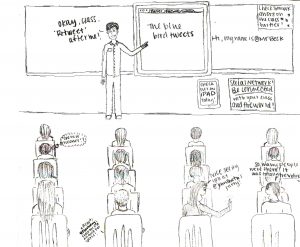 The home feed is refreshed. Close to 23 new posts have been added in the last 10 seconds. Petty issues over sleep deprivation and a longing to go home control the majority of news for students, but hidden in the mix is something of greater value.
The home feed is refreshed. Close to 23 new posts have been added in the last 10 seconds. Petty issues over sleep deprivation and a longing to go home control the majority of news for students, but hidden in the mix is something of greater value.
“Mike Janes @fhnactivities : Brenton Griffith and Brandon Chac qualified individually for Cross Country Sectionals. Best of Luck to all of our athletes! #FHNpride”
Social media is hot, it’s trending and it can hold a student’s attention for more than two seconds. According to a June 2012 study by Common Sense Media, 20 percent of students report their main social media site is Twitter, and 68 percent of students who use social media say that Facebook is.
So what was the faculty to do when students became permanently fused with their cell phone screens? Well, it took a lot of write ups, bargaining and lessons on how to avoid saying things like “tweeter,” but they did it. Several faculty, administrators and staff have made their way onto Twitter. They’re posting sports announcements, holding contests and keeping their clubs they sponsor up-to-date on events from their FHN accounts.
According to a recent study by the Pew Research Center Internet & American Life Project, 95 percent of teenagers, ages 12 to 17, use the Internet regularly. 80 percent of those students are using social media sites. Of those students surveyed, most reported that their school supports a BYOT (Bring Your Own Technology) or BYOD (Bring Your Own Device) policy.
Social media just makes sense. It is the way 80 percent of teens communicate. It allows alumni to keep in contact with past teachers on social media and ask them questions that apply to their life out in the real world.
@JoughBroxsmith [Joe Brocksmith] has replied to tweets from former students such as “Brocksmith, what is this animal?” Because he’s connected to his students on Twitter, his teaching can still reach beyond the bounds of the classroom walls or graduating years of his former students.
Social media can bridge the gap between students, teachers and even administrators. Activities Director Mike Janes, who runs the @ fhnactivities account, retweets accounts ranging from the @TheGoonies to @FHNHeadKnight. Now, students and administrators are able to relate to each other in a virtual community where they can both show their support for activities and sports around the school.
There is a lot of media attention given to inappropriate student-teacher relationships and horror stories on social media. However, those are very extreme cases and are not the norm. Most teachers, faculty, and staff tweet about school-related activities professionally. The light-hearted, open accounts of teachers at North are relating to their students on a different, virtual level. This social networking form of communication will be important to have in the classroom in the coming years because it will only develop further.
Not only are the students ready for social media integration but the teachers are too. A 2009 PBS report claims that 76 percent of K-12 teachers use social media. Of those K-12 teachers, 26 percent of them use a social networking site or some sort of online community for classroom instruction.
Each year, technology evolves. With the rapid spread of information on the Internet, it is not crazy to think social media integration could become a permanent part of more than 50 percent of classrooms by 2020. These studies show readiness for teachers to begin integrating social media in the classroom. The first step to introducing something new into the curriculum is teacher-readiness, and it looks like teachers are already getting a handle on Twitter [pun intended.]






![It's Time for the BOE to Respect Student Input [Editorial]](https://FHNtoday.com/wp-content/uploads/2024/11/Untitled_Artwork-1-1200x690.png)
![It's Time For a Change to Knight Time [Editorial]](https://FHNtoday.com/wp-content/uploads/2024/10/Untitled_Artwork-30-1200x900.png)
![The Time for Media Literacy Is Now [Editorial]](https://FHNtoday.com/wp-content/uploads/2024/05/IMG_1035-1200x737.jpg)
![It’s Time To Come Together [Editorial]](https://FHNtoday.com/wp-content/uploads/2024/03/Untitled_Artwork-1-1200x648.jpg)
![The New Board of Education Social Media Updates Are Outdated [Editorial]](https://FHNtoday.com/wp-content/uploads/2024/01/new-policy-ed-cartoon-1200x650.png)
![It’s Time to Update Missouri's Sex Education Regulations [Editorial]](https://FHNtoday.com/wp-content/uploads/2023/11/Untitled_Artwork-1200x694.jpeg)










![The November Issue [Comic]](https://FHNtoday.com/wp-content/uploads/2024/12/Untitled_Artwork-2-856x1200.png)